What is your city and state of residence?
Mission, KS, a suburb of Kansas City, KS.
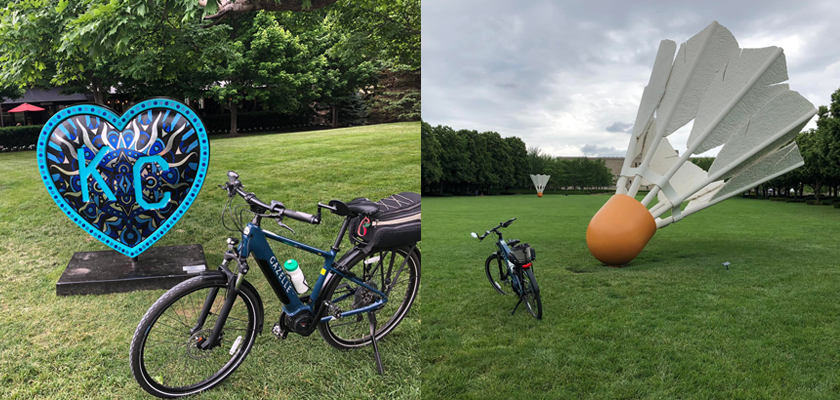
How long have you had your Gazelle?
As of March 2, 2025, I will have owned it for three years.
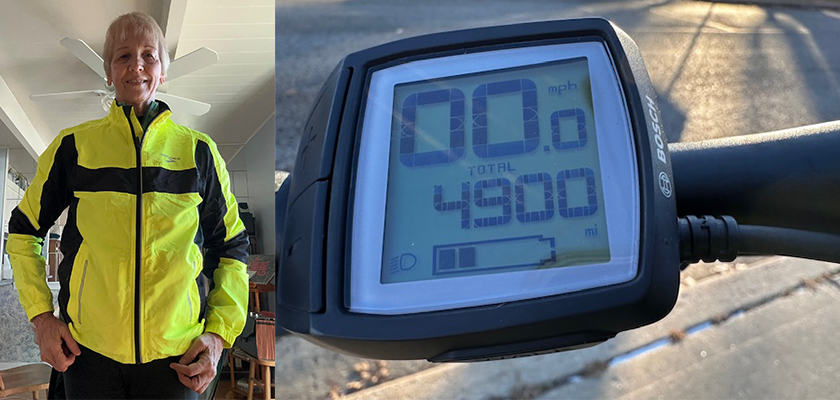
How long have you been riding and is this your first ebike?
This is my first ebike. I was given my first bike at 6 years old. I rode bicycles almost daily through high school and college, even in the winter since I didn’t have a car. After about a 20-year interval where I didn’t ride much, I got into the week-long, long-distance rides with my first one being Bike Across Kansas in 1999. I have done 2-3 week-long trip every year since then.
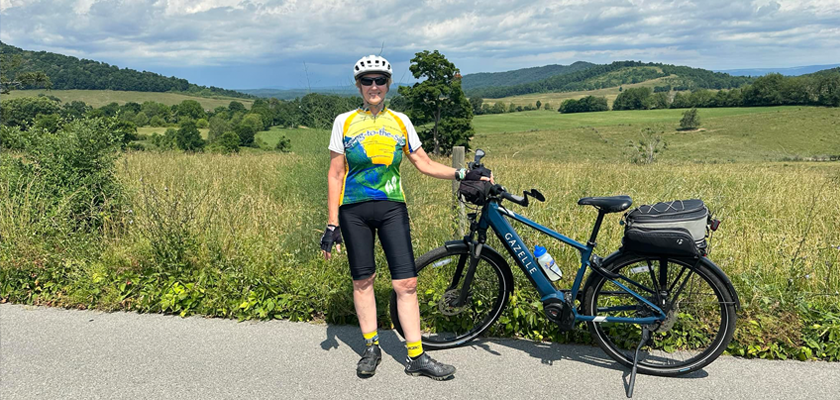
What was your motivation or rationale to get an ebike and what were the most important factors in your consideration or selection process?
I tore a meniscus in my knee when I slipped on some mud and fell while running. The knee took
forever to heal and one year post surgery the knee would swell up after riding my road bike despite physical therapy, icing, and steroid shots. I decided that if I still wanted to do the type of rides I liked to participate in, I would have to go electric. My dad had passed away a few years before that happened and I decided that I would use some of my inheritance to purchase an ebike.
Once I decided to go electric, I spent some time learning about ebikes and the different types, brands, and features on the internet. Then some friends and I spent a day going to all the bike shops that sold ebikes to look at them and talk to the shop about ebikes. Living in the Kansas City metro area gave me many options due to the number of bike shops in the region. Considerations included location of the motor, range of the battery, was the battery removable, and knowledge and friendliness demonstrated by the salesperson trying to sell me the bike. I quickly eliminated those models with rear hub motors and those where you couldn’t remove the battery. Some stores ignored us when we were looking at bikes so they were eliminated. One store had a salesperson who knew very little about ebikes. That one was eliminated, too.
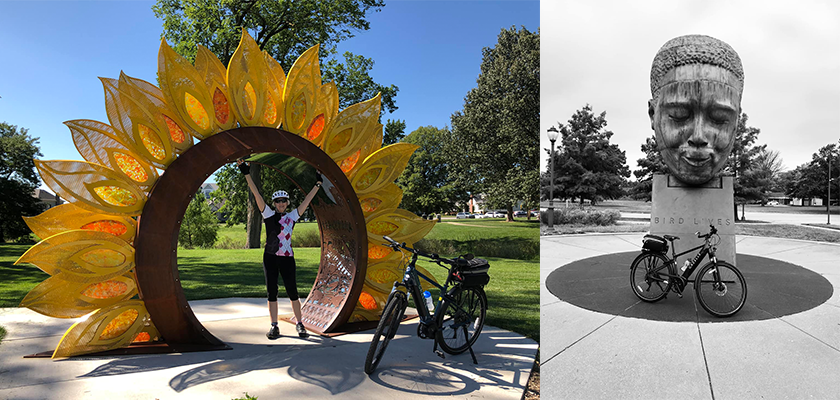
I chose the Gazelle Medeo T10+ from Midwest Cyclery in Kansas City, MO. They were the most knowledgeable of all the people I spoke with about ebikes and spent a lot of time answering all my
questions and asking me about my riding habits to help me select the bike that would best suit my needs. I took a 20-minute test ride and once I got used to the weight, getting started from a stop, and how to work the power levels, I was hooked. The Medeo T10+ is a high performance ebike and Class 3, which isn’t a problem since I do not ride on the paved trails in the metro area. I am a road rider. I started riding with a local group that I never could keep up with on hills. I had to carefully select the multi-day rides that year due to the need to be able to do the full day’s distance on one battery charge. After riding several week-long rides, I decided I needed a second battery since it was stressful worrying about whether or not I could make it to the end of each day’s ride. Fortunately, I never ran out of battery on any of those trips, but I was often stressed out. A year and a half ago I asked for a second battery for Christmas and had a carrying case custom-made so I can carry the spare battery on the bike with me.
Lastly, since I travel long distances to reach some of the rides I have done, I had to consider how to transport an ebike. Most ebikes are too heavy to hang from the suspended bike racks I have, so getting a platform rack was a must. Since the Medeo is heavy (about 52 pounds minus the battery), I knew I wouldn’t be able to lift it by myself so I selected a Thule EZ fold rack that has includes a ramp.
How has owning a Gazelle changed your life or your habits?
The ebike has made cycling more enjoyable. In the past, even when I was in good shape and on a
lightweight road bike, I could never keep up with the groups I rode with, I was very slow on hills, and I would finish a ride feeling exhausted. Now, I can keep up with faster riders and when I do the long-distance rides, I can maintain a higher speed so that I am not the last rider to reach the end of the route. I then have the energy to set up my tent and to do other activities in the evening instead of going to sleep early. Climbing hills and mountain passes at 7 mph instead of 4 mph is a game changer. In Kansas, especially in the western part of the state, the wind is always blowing and there are few trees to break the wind. Having the ebike reduces the effort needed to ride into the wind. I try to minimize my use of the power since I do want the physical benefits that come from cycling.
I found that the ebike allowed me to ride to work without getting sweaty. I would use more power than I needed in the morning so that I didn’t have to work as hard to get there. And, I didn’t have to wear different clothes. On the way home, I would use my normal power settings since I could shower once I got back home. My commute to work was about 4 miles one way, but there were a couple of short hills that took effort so I could just wear my normal work clothes, even in the summer.
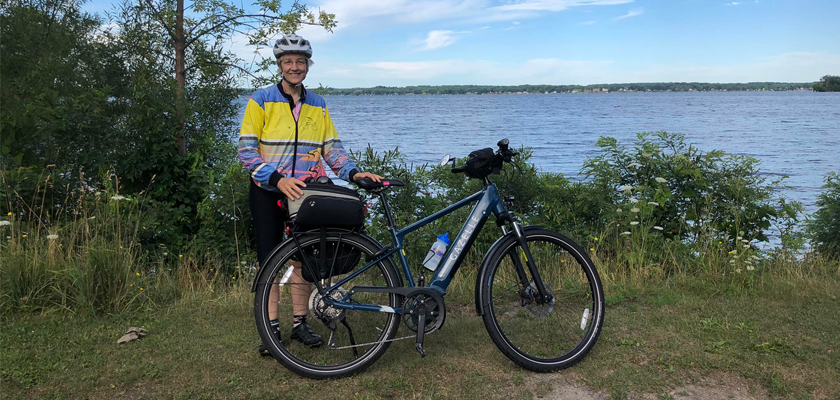
What is the primary use of the bike, fun, fitness, transportation, or a combination?
I use the bike for transportation: I rode to work before I retired, I ride to church, do errands, weather permitting. I also use the bike for socializing, riding with a local cycling group (the Riff Raffs) in the mornings.
What’s the longest, most challenging, or most memorable ride you have completed on your Gazelle?
I would have to say that the Big Bend National Park trip with Woman Tours was the longest trip at 8 days of riding, the most miles, and the most climbing.

Tell us a bit more about your recent big cycling trip. How long was it, how many miles per day did you ride, what was the highlight of the trip? Anything else you’d like to share about the trip?
I decided to do the Woman Tours Big Bend National Park trip after a friend said I needed to do it because it was a spectacular area of the country. I had never been to Southern Texas, so I signed up for the ride. This trip is considered one of Woman Tours Epic Tours since it was more than a week long with significant distances and challenging terrain. November is a great time of the year to visit Big Bend National Park since the day time temperatures are tolerable (warmest day we had was 88 degrees in the late afternoon). The mornings were in the upper 30s to low 40s, which just required a bit more layering. Once the sun was up though, the temperatures rose quickly. Extra clothing could be put in the support van or carried in our rack bags.
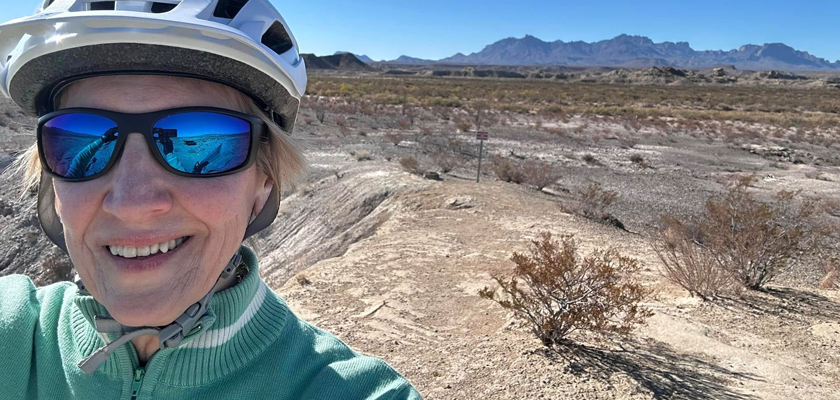
I met the group in Fort Davis, TX. Our accommodations during the trip were cabins and motels. After an orientation meeting and bike fitting for those who rented bikes, we had dinner at the property’s restaurant. On the Epic tours, a chef is part of the support crew. She prepared a hot breakfast most days and cooked 6 of the 9 dinners from the back of a trailer. The food was excellent and several of us had dietary restrictions that were addressed by the chef in the meal planning and preparation. Along the daily rides, we had a support van who set up SAG stops along the way. A second van was available as a SAG on the longer days and the two vans leap-frogged on the route so we had access to food and water about every 20 miles.
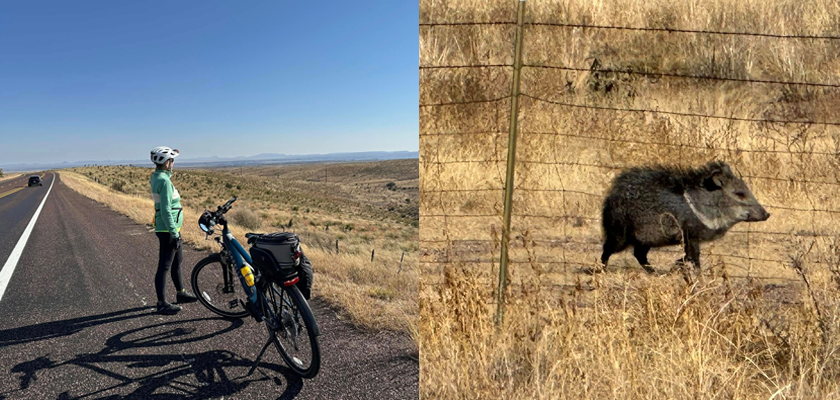
The first day was the most challenging. We did a 77-mile loop around the Davis Mountains. This included 4,158 feet of climbing and the same amount of descending since it was a loop. About half of the riders were on ebikes and the support van carried extra batteries for them. Most of the ebikes were Gazelles, but I couldn’t determine which model they were. During the ride we saw mule deer, javelinas, tarantulas, and road runners. Scenery was amazing and I seemed to be stopping every couple of miles to take photos.
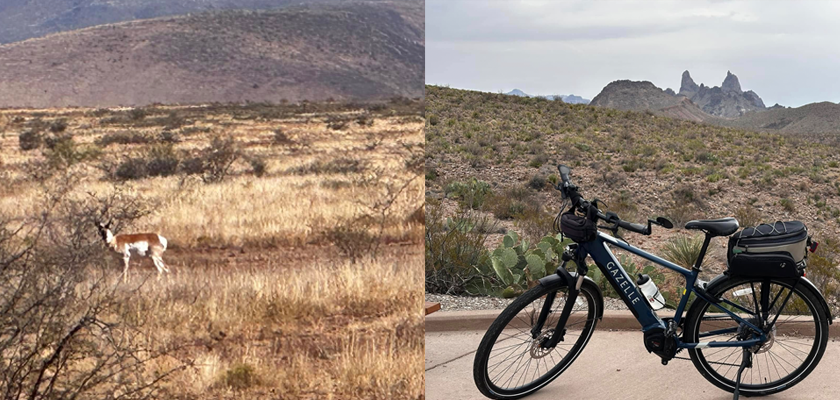
The second day was short and flat (26 miles), but everyone was pretty tired from the previous day, so no one really minded the shorter distance. The daily mileages for Days 3-5 were 60, 67, and 45 miles. Day 4 was notable for the scenery as we rode through Big Bend Ranch State Park. A wide variety of colors and shapes in the hills and mountains, and very little flat riding. We saw balanced rocks and hoodoos, the Rio Grande, and vistas that made me want to just stand and look at them all day. The most challenging climb we had was on this day. We had to do a 15% climb up Fresno Peak. It wasn’t that long of a climb, but it was the only time I went into Turbo mode during the trip. On bicycling trips, you see sights that you probably wouldn’t see anywhere else, because you have the time to look around and stop. For example, in Lajitas, TX, the mayor is a goat named Henry Clay who lives in a pen near the general store and loves to eat snacks.
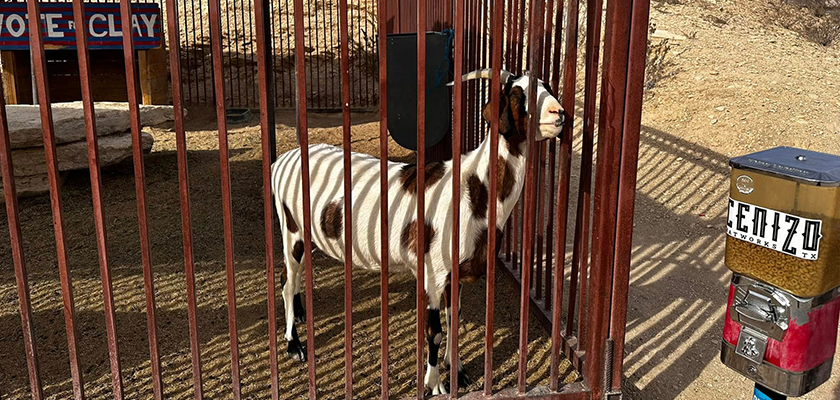
Day 5 was the first day we entered Big Bend National Park. There are only a few paved roads in the park; everything else is dirt roads that often follow dry creek beds. We rode to Santa Elena Canyon, which is one of the highlights of the park. It is very deep (1000 – 1500 feet walls) and narrow (100-150 feet wide) canyon. Most of the riders did the short hike into the canyon. The 45-mile ride to the canyon from Terulinga, TX included an gradual uphill for about 22 miles (2548 feet of climbing) followed by 22 miles of downhill. I love to go fast, so I often reached speeds of 30 mph or more. The area was formed by volcanic activity and there are places to stop with explanations of how the area formed. You can still see volcanic ash (now petrified) at the base of the mountains. It looks like snow from a distance. There are a couple of overlooks you can ride or walk to that give you a better view of the valleys or geologic features, like the Mules ears. Signage states that features like the Mules ears were used to guide travelers as they journeyed across the area.
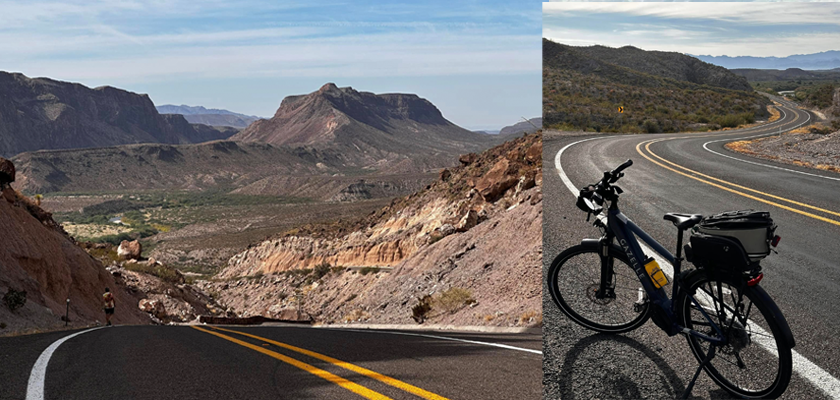
We stayed in Terulinga for 3 nights and the second day there included a canoe trip down the Rio Grande. The water was low, but the scenery in Dark Canyon was worth the trip. Day 8 sent us back into the National Park but on a different road in a different direction. A six-mile long downhill allowed me to cruise along at about 28 mph with minimal pedaling. Along the way I stopped at the Fossil Discovery Exhibit. It is a fully self-sustainable building that houses fossils excavated from the area, which used to be a sea. The fossils were impressive and the variety and size of the creatures that lived there was fascinating. It is hard to imagine this area as a sea since it is now high desert with minimal rainfall each year.
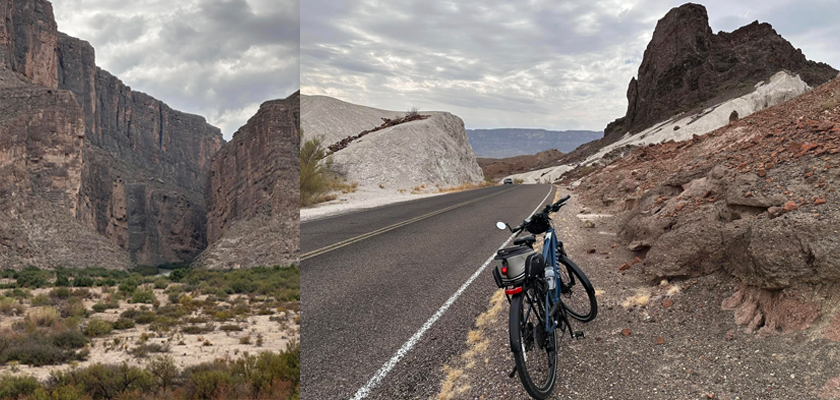
67 miles later, we arrived in Marathon, TX. This entire region of the country is a Dark Skies protected area. The towns all have changed their outdoor lighting to allow viewing of the night skies without the light pollution we have in more urban area. I saw the Milky Way and more stars than you can imagine, especially if you have never been to a dark sky area. It is a spiritual experience, to say the least, when you look up into the night sky. The last day of riding took us back to Fort Davis. It was about 56 miles, with 2000 feet of climbing. I was fortunate that I only had to switch out my battery on 4 of the days. The long downhills were great for conserving battery life. After a celebratory dinner at the restaurant and a good night’s sleep, I began my journey back to Kansas. Definitely a memorable trip that I will never forget.
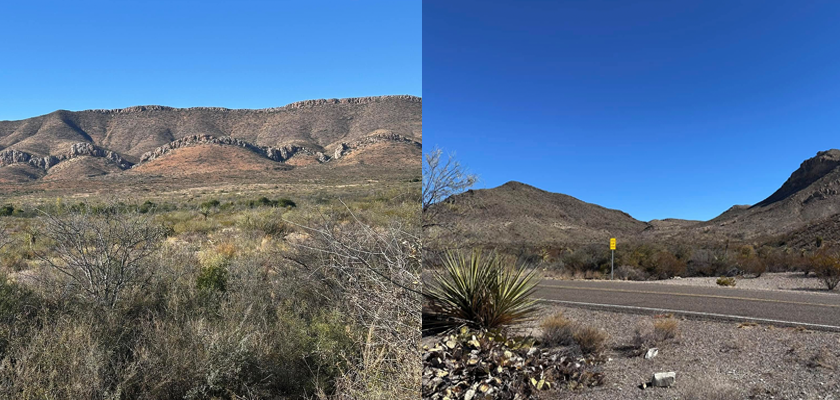
What is your dream location to ride with your Gazelle in 2025?
I am doing four rides this year that I have been looking at for at least a year or more. Woman Tours’ Death Valley ride in February, Cycle Zydeco in Lafayette, Louisiana in April, Ride Colorado, near Durango in August, and Woman Tours’ Chile tour of the Lake and Volcano region in December. I am considering WaCanId, which is the Selkirk Loop ride in Washington, Canada, and Idaho, but the drive would take me at least 2 days, maybe 3, to reach the starting point.
Since I was a college professor, I was limited to rides occurring during the summer months until I retired. The lack of opportunities to recharge the battery during the day considering the distances and terrain in the Colorado and WaCanId rides eliminated those until I got the second battery. I often contact the organizers of rides that I am thinking about doing to ask about services along the route (any convenience stores or roadside parks that might have electricity). I did the Bon Ton Roulet ride in New York before I had the second battery and all the SAG stops were in roadside shelters or churches where I could plug in for 30-45 minutes or so to ensure I made it to the end of the ride.
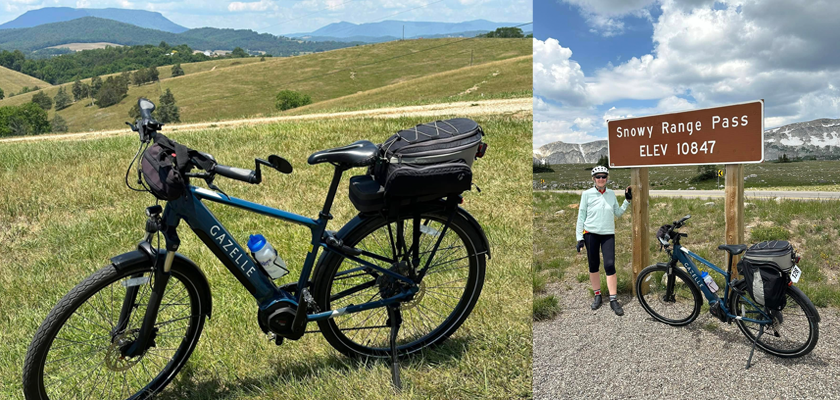
Do you have any advice for someone considering getting their first ebike?
First, figure out what kind of riding you do (distances, terrain, purpose for riding your bike). If you like long distances, the type of motor and battery range are very important. If you plan to use the bike for commuting and errands, can you attach panniers for carrying things? If it is just for social rides around your city, you can go with less battery range and less weight. My Gazelle is heavy compared to some of the other brands of ebikes, but some of my friends can only get 35 miles on a battery charge.
Do a lot of research before heading to the bike shops. The internet is a good place to start. This allows you to understand the lingo and figure out if the shop seems to know and understand ebikes and those who ride them. Talk to people who have ebikes. I spend a lot of time talking to people about my ebike, especially when I am doing errands. Once I went to the bike shop to pick up some items I needed and ended up talking to a young couple who were test riding ebikes for about 45 minutes. Spend time talking to the people at the shop where you might purchase a bike from. Ask about service time, look at the types of bike supplies they sell, talk to everyone who is there. If you aren’t comfortable with the shop, try another one.
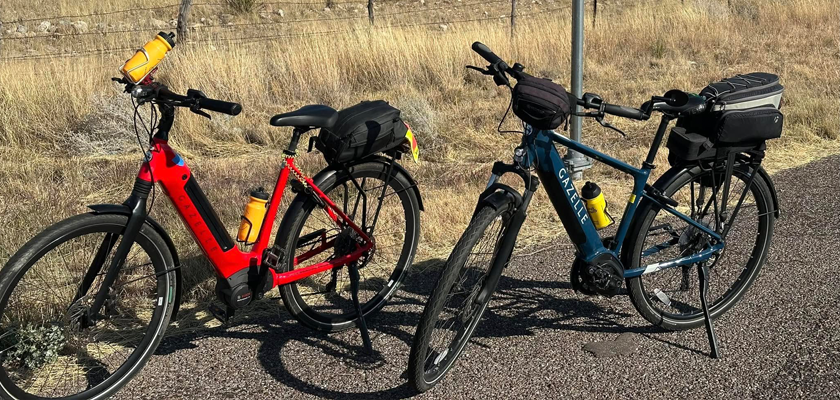
Anything else you would like to share?
On my last ride in December 2024, I rolled over 4900 miles. I am sure I will reach 5000 miles by my bike’s ‘birthday’. My personal mileage for 2024 was 2202 miles. I am very happy with my Gazelle and the support from Midwest Cyclery. I always visit them before each long ride just for a checkup. This is because on the long, supported rides I do, I never know if the mechanical support that accompanies the riders can handle any major repairs. Even after all this mileage, my chain has not stretched at all and the tires are still in good shape.
Lastly, I want analog bike riders who are considering switching to an ebike, to go for it. You can switch back and forth between the two styles of bikes if you want. I did do two week-long rides on a road bike (post ebike purchase on international trips – Italy and Cuba) because they were mostly flat with shorter distances. Don’t worry about your friends giving you a hard time for “cheating”. I tell anyone who wants to hear that because of my ebike, I am still riding and not sitting in my recliner knitting and eating bon bons all day. I decided a long time ago that I was not going to age gracefully – I am fighting it tooth and nail. Because I stay active, I am proud to say that at age 69, I take no prescription medication and have no health issues. I attribute that to exercise (mostly cycling) and a healthy diet.
Thanks for letting me share my Gazelle journey with all your readers.



